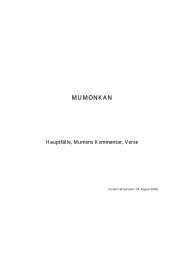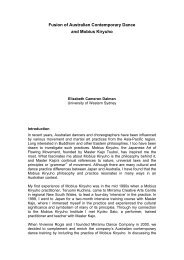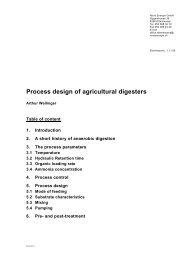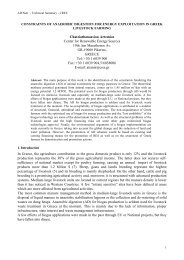III. No-Till Farming Systems - nifty
III. No-Till Farming Systems - nifty
III. No-Till Farming Systems - nifty
You also want an ePaper? Increase the reach of your titles
YUMPU automatically turns print PDFs into web optimized ePapers that Google loves.
ANNEX I<br />
New Book<br />
<strong>No</strong>-<strong>Till</strong>age Seeding in Conservation Agriculture<br />
Authors: Baker, Saxton, Ritchie, Chamen, Reicosky,<br />
Ribeiro, Justice and Hobbs<br />
Editors: C.J. Baker and K.E. Saxton (baker@crossslot.com)<br />
A Summary<br />
This 326-page book is an expanded second edition of <strong>No</strong>-<strong>Till</strong>age Seeding: Science<br />
and Practice (Baker, Saxton and Ritchie), first published in 1996. The second<br />
edition was commissioned by FAO (United Nations) and published jointly in<br />
2006 by FAO and CABI, England.<br />
FAO explained why it commissioned the book in<br />
a Foreword penned jointly by Shivaji Pandey and<br />
Theodor Friedrich. The preface is contributed by<br />
the editors and outlines why the book was written<br />
and how the reported science has already dictated<br />
the design of Cross Slot ® no-tillage technologies.<br />
The book’s 19 chapters draw on research conducted<br />
at New Zealand’s Massey University and<br />
U.S.A.’s Washington State University that<br />
helped identify and eliminate many of the causes<br />
of previous biological failures in no-till systems.<br />
Other research is reported from the U.S. Department<br />
of Agriculture; 4Ceasons Agriculture and<br />
Environment, U.K.; Instituto Agronômico do<br />
Paraná, Brazil; National Agriculture and Environment<br />
Forum, Nepal; and Cornell University,<br />
USA.<br />
The book sets the scene by outlining the fundamental principles of no-tillage. The<br />
first chapter reports the benefits of no-tillage, many of which are due to maintaining<br />
or increasing soil carbon levels. These benefits are given some perspective in<br />
a chapter on risks (biological, physical, chemical and economic) associated with<br />
no-tillage systems. The authors argue that the risks of crop failure (or even partial<br />
505














